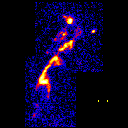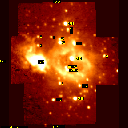


The above is an image of L1448 taken in the molecular hydrogen 1-0 S(1) line with our 256x256 InSb camera. This image was taken at the Wyoming InfraRed Observatory (WIRO). For more information on L1448 please contact Francois Piche at piche@sherman.pas.rochester.edu

This is a Brackett gamma image of the inner ~ 1kpc region of M82. The cross is the position of the nucleus. This image and the images that follow were taken using a Fabry Perot interferometer in combination with our 256x256 camera in a collaboration with NRL, and NASM LfA at WIRO.
The above images show the extinction to M82. The first is an image of the extinction in the same region as the Brackett gamma image generated by the Paschen beta to Brackett gamma line ratio. The image is clipped at the 2 sigma Brackett gamma contour. The second is an image of the extinction in the same region generated by the H-K color. For more information on the M82 images please contact Shobita Satyapal at laps@isis.pas.rochester.edu

This is an image of the high mass starforming region MonR2 at 2.2 microns generated as a mosaic of images taken with our 58x62 InSb infrared array camera. All of the 58x62 images presented were taken at the Mt. Lemmon Observing Facility (MLOF) 60" telescope.
This is a "true color" image of the K3-50A high mass starforming region. 1.23 microns is mapped to blue, 1.65 microns to green, and 2.23 microns to red. The object to the right is a foreground star.
In addition to broadband near infrared images, we also use a circular variable filter to generate ~1% resolution spectral images.
The above is an image of MonR2 in ionized hydrogen (Br alpha line) in red combined with the 3.29 micron dust emission feature in green
The image on the left is an image of the dust extinction to the MonR2 HII region (darker regions indicate greater extinction) generated by comparing a radio image to a Br gamma ionized hydrogen line image. The image on the right is an image of the [H-K] (1.65 - 2.23 microns) color of the same region. For more information on the K3-50A images, contact Eric Howard. For more information on the MonR2 images see Howard et al. 1994, ApJ 425, 707.